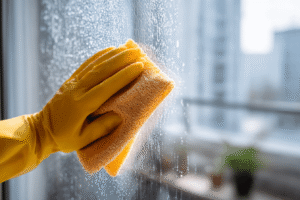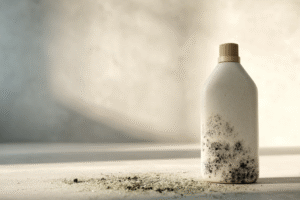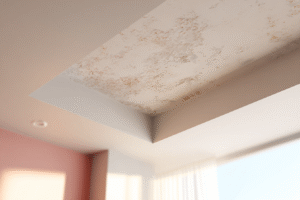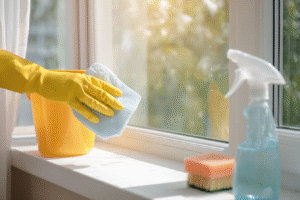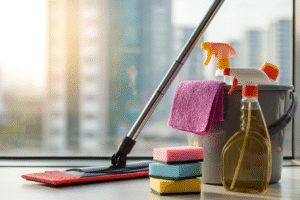Summarise this article with:
Your washing machine works hard to keep your clothes fresh and clean. But have you ever stopped to think about cleaning it? A dirty washing machine can lead to smelly laundry, mould build-up, and even breakdowns. The good news? With just a little TLC, you can keep your appliance in top shape—and our expert domestic cleaners are here to show you how! This step-by-step guide makes cleaning your washing machine quick, easy, and satisfying. Let’s get started!

Why You Need to Clean Your Washing Machine
Even though it’s constantly exposed to water and detergent, your washing machine isn’t self-cleaning. In fact, leftover detergent, limescale, bacteria and mould can build up over time. This grime often hides in places you don’t see—like the filter, rubber seals and detergent drawer.
Signs Your Washing Machine Needs Cleaning
Not sure whether it’s time to clean? Here are a few signs to watch for:
- Musty or sour smells from the drum
- Black mould or slime around the door seal
- Clothes that come out less than fresh
- Water not draining properly
- Visible detergent or fabric softener build-up
Best Ways to Clean Inside a Washing Machine
Let’s break down how to clean the drum of your machine—the core of every wash cycle.
Essential Cleaning Supplies Needed
Before you begin, gather these items:
- White vinegar
- Bicarbonate of soda (baking soda)
- Microfibre cloths
- Old toothbrush
- Optional: washing machine cleaner/descaler
Step-by-Step Drum Cleaning Process
Ready to bring back the sparkle? Follow these simple steps to deep clean your washing machine drum:
- Empty the machine completely: Make sure there are no clothes, towels, or laundry items inside.
- Sprinkle 2 tablespoons of baking soda directly into the drum: Baking soda is a natural cleaner that tackles odours, stains, and grime. Distribute it evenly around the base of the drum for maximum effect.
- Pour 500ml of white vinegar into the detergent drawer: White vinegar acts as a powerful descaler and deodoriser. Pour it into the detergent compartment to allow it to flow through the system, breaking down soap scum, mineral deposits, and hidden bacteria in pipes and nozzles.
- Run a hot wash (60°C or above) on an empty cycle: Set your machine to the hottest and longest cycle available—ideally a cotton or intensive program. The heat, combined with vinegar and baking soda, lifts off dirt and kills germs lurking deep within the system.
- After the cycle ends, grab a clean microfibre cloth and wipe down the inside of the drum, the door, and the rubber seal. This final step removes any loosened residue and leaves your washing machine fresh and spotless.
Deep Cleaning Techniques
Repeat the vinegar-baking soda wash twice in a row: If the first cycle removes a lot of dirt but the machine still smells or looks grimy, don’t hesitate to do a second cleaning run.
After the first hot wash finishes:
- Add another 2 tablespoons of baking soda to the drum.
- Pour another 500ml of white vinegar into the detergent drawer.
- Run the hottest, longest cycle available again.
- This double-clean method is brilliant for tackling stubborn odours and residue build-up.
Use an old toothbrush to scrub drum holes and inner rim: After the cleaning cycles, inspect the drum closely. Sometimes grime hides in tiny drum holes or around the inner rubber rim.
- Dip an old toothbrush into vinegar.
- Scrub the drum’s holes gently to dislodge trapped dirt or lint.
- Wipe everything down with a clean, damp cloth once you’re finished.
- Pay special attention to the inner door rim and corners—these areas love to trap moisture and grime!
How to Clean Washing Machine Components
To truly freshen your washing machine, you need to go way beyond the drum.
Cleaning the Door Seal and Rubber Gasket: Getting Rid of Mould
- Removing Mould and Bacteria on Seal
To tackle mould and bacteria in your washer’s seal, gently pull back the rubber door seal and inspect hidden areas. Spray white vinegar directly onto any mould patches, leave it to sit for 5–10 minutes, then scrub with an old toothbrush to lift away grime. Finally, wipe everything clean with a damp cloth to leave the seal fresh and hygienic.
- Maintaining and Preventing Seal Damage
To keep your washing machine seal in good condition, avoid forcefully pulling or twisting it and steer clear of harsh chemical cleaners that can damage the rubber. After every wash, simply wipe the seal dry with a cloth and leave the door slightly open to help it air dry naturally—this easy habit helps prevent mould and prolongs the life of your machine.
Tackling the Detergent Drawer
Over time, detergent and fabric softener leave behind a sticky mess.
- Dismantling and Cleaning Process
To clean your washing machine drawer, start by fully removing the drawer from the machine—check your washing machine’s manual if you’re unsure how, as some models have a small latch or button to release it. Once removed, soak the drawer in a basin of warm, soapy water for about 15–20 minutes. This loosens any dried detergent, fabric softener, and mould.
After soaking, use an old toothbrush to scrub all the compartments carefully, paying special attention to corners and hard-to-reach spots where residue tends to build up. Rinse thoroughly with clean water, then dry it completely with a cloth before sliding it back into the machine.
Cleaning the Filter
Start by placing old towels near your washing machine’s drain pump to catch any water. Most front-loading machines have their filter behind a small panel at the bottom right corner. Turn the filter counter-clockwise to remove it, allowing trapped water to drain slowly into a shallow container.
Remove any collected debris like coins, buttons, or hair from the filter mesh. A thorough rinse under warm running water helps dislodge stubborn lint and soap residue. Gentle brushing with an old toothbrush can remove persistent buildup without damaging the filter’s delicate structure. Before reinstalling, check the filter housing for remaining debris and wipe it clean with a damp cloth.
Dealing with Specific Washing Machine Issues
Sometimes, regular cleaning isn’t enough. Here’s how to tackle specific problems head-on.
Removing Bad Odours
Bad odors in your washing machine often stem from bacteria, mould, and detergent build-up. To eliminate these unpleasant smells, run an empty hot cycle (60°C) with 2 cups of white vinegar and a handful of baking soda. For persistent odors, clean the rubber seal, detergent drawer, and filter thoroughly, as these areas commonly trap moisture and debris. To prevent future smells, leave the door and detergent drawer slightly open after each wash to allow proper air circulation and wipe down the rubber seal regularly.
Tackling Limescale and Mineral Deposits
Limescale and mineral deposits are common problems in washing machines, especially in areas with hard water. These chalky white deposits can build up on the heating element, drum, and pipes, reducing your machine’s efficiency and potentially damaging its components. To remove them, run an empty hot cycle with a specialized descaling product or a mixture of white vinegar and water. For prevention, consider installing a water softener or using anti-limescale tablets with each wash to protect your machine from mineral build-up.
Keeping your washing machine clean doesn’t have to be a big chore—it just takes a little regular care to keep it fresh, efficient, and working beautifully. A clean machine also means a longer-lasting appliance, saving you from costly repairs down the line. Just a few minutes of maintenance each month can make all the difference!
Remember, if you ever need a helping hand with your home cleaning, Wecasa is here for you. Our trusted professionals bring the sparkle back to your space, so you can sit back, relax, and enjoy the fresh feeling—without lifting a finger.




